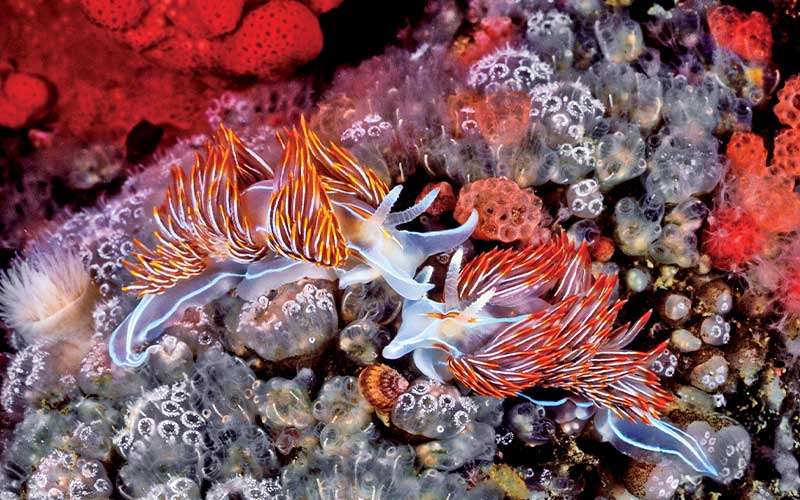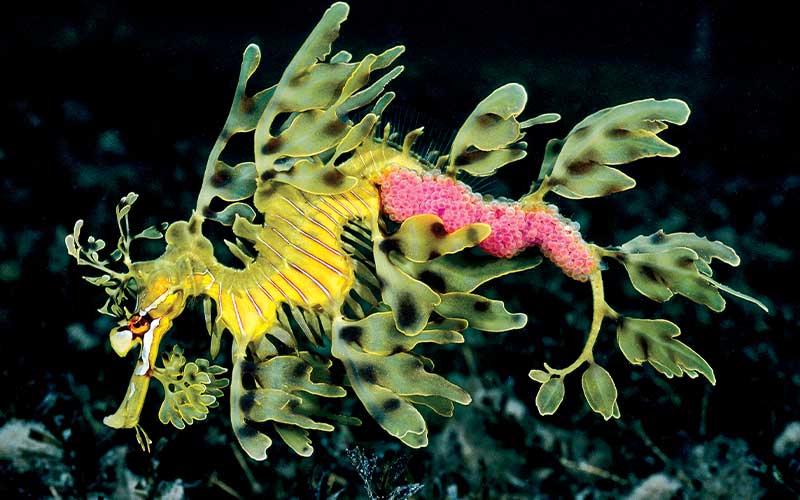My very first dive was in icy water at an abandoned quarry in New York state. The underwater visibility was less than a foot, and I could barely make out the dive instructor’s hand signals as he watched me demonstrate my skills. I came away with a basic scuba certification and a desire never to dive in cold water again.
Over the next two decades I logged thousands of dives, all of them at tropical Caribbean or Indo-Pacific locations. My photography improved steadily, but eventually I felt stifled. I had the distinct feeling I was repeating myself, and the intriguing images I saw from cold-water photographers revealed seemingly impossible creatures. I had to see it for myself, so at long last I abandoned my resolve never to dive in cold water and took the plunge.
Getting Started
Underwater photography is technically challenging and requires good concentration, which in turn requires a certain level of comfort. In cold water this means staying warm. Becoming familiar with a drysuit can be reasonably regarded as a necessary first step toward mastering cold-water photography.
When I acquired my first drysuit almost 20 years ago, I made the mistake of bringing a camera on my very first dive with it. I spent a good part of that southern California dive struggling to keep my feet from floating up over my head. I left my camera behind for the next go-round and focused instead on learning to control my trim and buoyancy. At first, air within the suit seemed to shift unpredictably, wreaking havoc with my body position in the water. But I soon learned how to anticipate this phenomenon and modulate it. By the third dive I was comfortable enough to carry a camera and capture a few images of the remarkable giant kelp environment.

Location, Location, Location
All photographers have their favorite destinations, and my foray into cold-water photography has taken me to some truly remarkable spots. Part of any photo technique is knowing where to find the shot, and exciting cold-water shots can be found all over the world.
Water temperature in British Columbia does not vary much with the seasons and is typically 45-50°F. Browning Pass, located near Port Hardy at the northern tip of Vancouver Island in British Columbia, features some of the finest diving in the Pacific Northwest. Tidal currents can be quite strong, and many of the best sites can be dived only at slack tide.

The signature dive is Browning Wall, a steep dropoff on the western side of the pass that begins at the surface and descends hundreds of feet. The sheer density of living things is amazing and includes crimson and plumose anemones, red soft corals, colorful sponges, candy stripe shrimps, Irish lord sculpins, grunt sculpins, warbonnets, giant octopuses and several kinds of nudibranchs. There is so much life on this wall that focusing attention on one subject at a time is difficult at first.
The size of many of these animals is impressive. Most tropical nudibranchs I was familiar with are less than an inch long, but most of those witnessed in British Columbia are several inches in length, while the white plumose anemones boast a height of 3 feet or more. The sunflower sea star is the world’s largest; this voracious predator reaches 4 feet in diameter and may have as many as 24 arms. The giant Pacific octopus is the largest of its kind with an average weight of 33 pounds and an arm spread of 14 feet, though larger specimens have been reported. The spectacular lion’s mane jellyfish, a common species in these cold waters, can reach 6 feet in diameter with tentacles 30 feet long. Male Steller sea lions can reach a ton or more; they are the largest of the eared seals and the fourth-largest pinniped. Compared to the tropics, this is wildlife on steroids.
The variety of life, especially invertebrate life, in the Pacific Northwest is also extraordinary, and many of the animals and species are endemic. There is more than enough to keep an intrepid photographer busy.
New Zealand
My first foray into New Zealand waters was at the Poor Knights Islands Marine Reserve. We wore thick wetsuits, gloves and hoods and spent a lot of time shivering, but the diving was excellent. The marine life was a mixture of warm- and cold-water species in a rocky, kelp environment. I photographed moray eels entwined in kelp and many large nudibranchs I had not seen before. Cold-water species included the John Dory and large schools of blue maomao.
I returned with my drysuit three years later to spend a couple of weeks diving the Poor Knights along with a third week at Milford Sound. The latter is one of the deep fiords within Fiordland National Park on the southwestern tip of the South Island. Numerous waterfalls spill into the sound, depositing an enormous volume of runoff from the surrounding rainforest and resulting in a permanent 15- to 20-foot freshwater layer on top of the ocean water. The freshwater is tea-colored from decaying forest vegetation and absorbs a great deal of light. As a result, deepwater species, such as huge colonies of black coral, can be found in relatively shallow water.
South Australia and Tasmania

A long-standing desire to photograph sea dragons placed southern Australia on my cold-water list. Twice I visited Kangaroo Island in South Australia, mainly for leafy and weedy sea dragons. But on my third visit I concentrated on the jetty at Edithburgh, also in South Australia. The diversity of life under this one small jetty was nothing short of amazing. I came away after 10 days with photographs of five different species of frogfish, blue-ringed octopus with eggs, pajama squid, giant cuttlefish, ornate boxfish, short-headed sea horses and other photogenic species.
After Edithburgh I headed for the Tasman Peninsula in southeastern Tasmania. Giant kelp can be found at several of the dive sites here and make an excellent backdrop against which to photograph weedy sea dragons and potbelly sea horses. Most handfishes (small, bottom-dwelling anglerfish) are endemic to Tasmania, and on one trip I was able to take the first-ever photographs of a pair of red handfish guarding their eggs.

Japan: The Izu Peninsula
Japan’s temperate waters offer fascinating photo opportunities, and the diving at Izu was like no other place I have seen. The water is too cold for reef-building corals, but large soft coral and gorgonian coral colonies are common. There is a unique mixture of tropical fish families such as lionfish, cardinalfish and morays as well as cold-water species such as the endearing dwarf lumpfish known as dango-uo (literally “dumpling fish” in Japanese). Other particularly photogenic subjects include dragon morays, pinecone fish, frogfish and two endemic sea horses.
Closer to Home
Many divers living in temperate countries have learned to dive in nearby cold water, and many continue to do so because it is convenient, inexpensive and efficient. If you live on or near the East Coast of the United States, there is good diving in many places, including northern New England, New Jersey and North Carolina. The Midwest offers interesting aquatic life in many freshwater lakes and ponds. The West Coast, from California to Alaska, is home to some of the most enthusiastic cold-water divers I’ve met; it’s no surprise with the abundant marine life ready to amaze and entertain.

Tips for Good Photos and Safe Dives
Cold-water photography does require a special set of skills, many of which relate to thermal considerations and equipment skills that apply to any dive you do, especially in colder climates.
- Acquire a good drysuit, and become comfortable with its use. Bring enough thermal underwear to stay warm along with a patch kit and replacement latex seals for emergency repairs in the field.
- Accessorize the suit to meet your needs. Pay special attention to things like hand warmth, bladder-related options and weight systems.

- Always carry at least one sharp dive knife or strong pair of scissors where you can reach it quickly. It is all too easy to become entangled in kelp while concentrating on photography; if you are low on air when this happens the result can be deadly.
- Do some basic research to become familiar with the appearance, habitat and behavior of the cold-water marine life you hope to photograph. Call ahead to learn the optimal times to visit various destinations; seasons can affect visibility and other conditions.
- Bring your wide-angle lenses, including a fisheye lens. This may seem counterintuitive for destinations known for excellent macro photography, but the comparatively large size of much of the invertebrate life in cold water creates opportunities for wide-angle photography that doesn’t exist with similar (but smaller) tropical species. In addition, the limited visibility in cold water often requires a closer approach to large subjects or scenes, which in turn requires a wider lens than might be required in clear water.
- Carry a good flashlight or modeling light, especially when doing macro photography, to aid in finding and focusing on small subjects in dim light. I prefer relatively small, rechargeable lights with a variable output and a wide beam, such as the Fisheye FIX LED and Light & Motion Sola lights. These are also excellent lights for night diving.
- I favor near-neutral buoyancy for my housing/strobe combination, particularly for close-up work. This facilitates steadying, focusing and firing the camera with just one hand when holding on in surge or current and prevents wrist fatigue while waiting for a subject to cooperate. I use supplementary flotation in the form of a pair of high-density, noncompressible foam floats, one on either side of the housing, positioned in line with its center of gravity. This creates a package within 3 to 4 ounces of neutral that will remain stable regardless of the housing’s position.
- Cold water generally contains many suspended particles, so it is especially important to limit backscatter. Get as close as possible to your subject, and position your strobes well off-camera, typically 45 degrees or more, to avoid lighting particles in the water column between lens and subject.
- Your strobes will be absolutely necessary to highlight the almost unimaginably rich colors of cold-water ecosystems and combat the low levels of ambient light. Slower shutter speeds and higher ISO settings can help open up the dark water backgrounds.

Most important, be honest and realistic when you assess your readiness for cold-water diving. Diving in 50°F water in a drysuit may require the use of more weight, the ability to deal with strong currents, dim light, poor visibility, surge and the loss of sensation and dexterity caused by the use of thick neoprene mitts. It typically requires a higher level of physical conditioning, training and experience than warm-water destinations.
But the payoff comes in the form of images of spectacular new subjects as well as the opportunity to surface in the shadow of an ancient Shinto temple or a majestic fiord with eagles circling overhead. For jaded warm-water divers who think they’ve seen it all, there’s another whole world to be discovered and explored.
Explore More
© Alert Diver — Q4 Fall 2011